2025 Ducati Panigale V4S Review – First Ride

Ducati’s flagship is the beneficiary of MotoGP input
MotoGP has been called the Ducati Cup in recent years because the brand takes up a third of the grid – and they’re all usually at the front. Granted, I suppose the kind of criticism is warranted if you like a little variety with your racing, but the reason behind all those bikes is more nuanced than just wanting to steal the show. Ostensibly, team boss Gigi D’alligna’s job was to bring Ducati back to the top. Doing so meant creating a bike that could win. Creating a winning bike requires data. What’s the best way to get data? By having as many bikes as possible equipped with the best riders in the world, effectively creating the best test team in the world, too. This was the fast track to data collection that Gigi and his team then used to make a MotoGP machine everybody now wants to be on. Here’s a poignant quote from Guilio Fabbri, Head of Communications for Ducati: “In 2007, we had a motorcycle that only one person could ride (Casey Stoner). Now, we have the most desired bike on the grid.”
2025 Ducati Panigale V4 S
The biggest evolution of the Panigale V4 since its introduction in 2018, the 2025 version chases speed not through horsepower, but through handling. With a dose of electronic assistance.
Highs
- Chassis improvements make it easier to ride at the limit
- eCBS and DVO are big steps forward in the electronics world
- The V4 engine is still a force to be reckoned with
Sighs
- Hopefully half the owner’s manual is on navigating the menu screen
- Ducati says the looks are inspired by the 916. We’re not so sure about that
- 33-large is nothing to sneeze at
Clearly Ducati are back to winning ways in MotoGP – but who cares? It’s not like we mortals will ever get to ride a GP24 anyway. No, but bikes like the Panigale V4 (and eventually the entire Ducati product line) inherit all kinds of tech first developed in racing. And in the case of the 2025 Ducati Panigale V4 S, the link between racing and production is closer than any Panigale before it.
Where Racing Meets Production
Since its introduction in 2018, the goal for every subsequent Panigale V4 has been to make it not only faster, but also easier to ride, so you can maintain the extra speed for longer. It was an easy goal when you consider the first-generation Panigale V4 had a killer engine with a very rigid chassis, making even a single fast lap time a lot of work. There was a big step in 2020 towards this goal with a chassis tweak for more lateral flex and improved electronics. Then again in 2022 with essentially more of the same.
Eventually, however, a big step was needed. Software updates will only take you so far and the front chassis can only give so much before it needs a helping hand from the back of the bike. Factor in the incredible lean angles possible from today’s slick tires – up to 65 degrees! – and a major step was needed to provide any sort of suspension feedback when the fork and shock are virtually useless at those angles.
The answer was in front of Ducati’s face all along. Ducati MotoGP bikes have always used a double-sided swingarm. As far as chassis dynamics go, it’s well known the single-sided arm is inferior in so many ways. But we can all agree that it’s superior in one major way: looks. Appearances and tradition have kept the single-sided swingarm around since the 916, but with the 2025 Panigale V4, Ducati are on a quest for speed, and as the company has shown with the very existence of the V4 engine in the first place, it’s not afraid to ditch tradition to find it.
Thus we start with the single most controversial piece on the new Panigale: the double-sided swingarm. As Dennis Chung mentions in his First Look story covering the major changes to the MY25 Panigale V4 S, Ducati actually tested a double-sided swingarm against a single-sided version. Clearly the double-sided version won out. Not only did the test riders prefer the feel and feedback it gave, but mass-producing a single-sided version that met all the same flex targets would cost beyond the scope of what is already an expensive machine. Oh, and Ducati were adamant the swingarm would still have space for an underbelly exhaust (shout out to Erik Buell…).
In all, the new two-sided swingarm reduces lateral stiffness by 37% compared to its predecessor, provides more mechanical grip, and is part of an overall package of swingarm, wheel, and caliper combo that weighs 6 lbs less than before. Having had the chance to touch the new swingarm independently from the rest of the bike, it’s surprising to see – and feel – how thin the wall thicknesses are.
The same goes for the front frame. Like the rear, it too has thin wall construction, with a staggering 40% reduction in lateral stiffness compared to before and a 17% reduction in weight. Again, when working together with the rear, it gives the rider more feel, feedback, and grip to attack the apex with more confidence than you could before. In fact, this was the key ingredient to making the Panigale V4 faster – simply making it handle better. While yes, the engine is slightly more powerful this year thanks to higher-lift valves (to the tune of 209 horsepower in the US, 216 for Euro models), getting more power wasn’t the aim – harnessing it was.
To that end, while the Öhlins electronic suspension is not new, it has been updated to provide more accurate damping customization. It’s also better able to detect and respond to the initial acceleration phase to better manage load transfer front to rear. By that same token, since the Panigale is a street bike after all and is not always going to be shredding racetracks, the system can also detect when the bike is cruising and can automatically adjust for more comfort when you’re rolling down the road.
But cruising is not what the Panigale V4 is all about. Other hardware tweaks include a revision to the bodywork to give a 4% reduction in drag, though most people are instead going to talk about the color-matched winglets and new nose design looking weird. From the saddle the rider’s cockpit has been tweaked to help keep you in the bubble longer. The seat is both longer (+1.4 in) and wider (+2.0 in), the pegs are 0.4 in further inwards, and the 4.5-gallon fuel tank is not just reshaped with a much more defined cutout to lock the outside leg in turns, but also features a strategically placed textured surface right where the knee meets the tank to help the rider grip the tank. This is especially useful when you’re hard on the brakes at high speeds and need to support your body.
Electronics Steal The Show – Again
Just because Ducati focused heavily on redesigning the chassis doesn’t mean it forgot about pushing the boundaries of the electronics. The 2025 Panigale is the first to feature Brembo’s new Hypure calipers that boast a total 60 gram weight reduction compared to the Stylemas before it, but also boast better heat dispersion and an improved pad retention system resulting in 15% less drag from the pads touching the calipers when you’re not touching the brake lever.
Paired to these new brakes is the introduction of Race eCBS. The 7-level braking system takes linked braking to a whole new level, but the headline-topping version of eCBS is its race-dedicated Level 1. Here, the ABS is set to its least intrusive setting so you can bury the front without fear of locking up or having the ABS kick in too early. With the new Track Plus setting comes a “Post-Run” feature, that will apply rear brake pressure without you touching the rear lever at all. As you’re releasing the front brake and getting back on the gas, it’ll apply varying amounts of rear brake to help you finish off a corner. Ultimately allowing you to accelerate sooner and/or with more throttle opening.
As you move up the different levels of the system, the operation parameters aren’t so straightforward. Here’s a breakdown of the different levels:
- Level 1: Maximum, time-attack ABS performance, combined braking, Track Plus
- Level 2: As level 1, no combined braking action
- Level 3: Smoother, track-oriented ABS performance, combined braking, no Track Plus
- Level 4: as level 3, no combined braking action
- Level 5: Track-oriented combined action, Slide-by-brake function
- Level 6: road-oriented ABS action, stable deceleration, maximum rear-lift mitigation
- Level 7: wet road action, maximum overall stability
Having the first five levels of ABS dedicated to some sort of track performance shows how all-in Ducati are with this package and being able to get all riders, regardless of skill level, to be able to ride faster, for longer, and with more confidence.
But no more is that true than with Ducati’s new DVO, or Ducati Vehicle Observer technology. DVO is a little tricky to explain, so let’s first start with Ducati’s explanation:
The system effectively monitors the Panigale V4 using sensors capable of measuring seventy physical quantities in addition to those detected by the IMU. This allows a precise estimate of both the operating thrusts and the maximum forces that the bike can tolerate at that specific moment.
Thanks to the additional data calculated by the DVO, the DTC and DWC controls can define the slip and wheelie angles with much greater precision than what occurred using only the data provided by the inertial platform. This allows the controls to intervene using a predictive mode, allowing the rider to exploit the motorcycle with more confidence.
To start, no, there aren’t 70 sensors on the new Panigale. DVO is able to predict values of up to 70 different sensors. How? To put it as simply as I can, we again go back to Ducati’s racing and testing experience and the collection of data. While the Panigale V4 doesn’t have 70 sensors on it, Ducati race and test bikes do (and more). They have for several years. Every possible way the laws of physics can act on a motorcycle (ridden like it was intended), Ducati have quantified via sensors and potentiometers. That data is then used to verify the numbers returned from test bikes without those same sensors and potentiometers. When those numbers repeatedly come extremely close (they’ll never be a perfect match), then Ducati engineers can build an algorithm to replicate various sensors, confident their previous testing will provide accurate results.
In essence, DVO is able to understand the numerous forces acting on the motorcycle that can’t be measured in practice. Ultimately, these forces impact the motorcycle’s ability to accelerate and dictate the maximum amount of torque that can be delivered to the tire. And don’t forget, dynamic factors like tire wear and the reduced vehicle weight due to fuel consumption affect these values. DVO is accounting for these factors in real time and is, in effect, acting like a second brain in addition to the IMU to feed the ECU as accurate a data set as it can to define the slip and wheelie angles for the traction and wheelie control to act even more predictively instead of reactively.
Obviously, Ducati would say its new bike is better than the old one. But this time it felt a little different. It was said with some real fervor and backed up with lap times from an internal test involving seven riders of varying skill levels, last year’s bike, as well as two competitor models. All seven riders went quickest on the 2025 Panigale V4.
Final proof that the new Panigale is faster and easier to ride? At the 2024 edition of the Race of Champions at World Ducati Week in Misano, where Ducati unveiled the new V4, its own GP riders, WSBK stars, and special guests raced in a “friendly” (quotes because Nicolo Bulega didn’t think it was very friendly) where Pecco Bagnaia set the fastest lap with a 1:35.05 – a whole second faster than the 2024 bike he currently trains with and less than five seconds off his fastest time during the recent MotoGP test. In fact, all the GP riders went faster on the new bike than the old. A fact made even more impressive when you consider the riders only had two 15-minute sessions with the bikes before the race – and none of them had ridden the bike at all before that.
A Lap of Vallelunga
To find out, Ducati invited 20 journalists to try the new Panigale V4 S around the Vallelunga circuit near Rome. Without having the old model to do a true back-to-back test with, this would still be a great opportunity to understand what the bike could do. Vallelunga is a track filled with variety, as the first half of the track consists of extremely fast, sweeping corners that reward bravery, while the second half of the track is slow and tight, rewarding precision. Having that sort of mix emphasizes the importance of a good chassis, and with 216 horses on tap, the electronics package proved vital – especially as the tire wore.
No matter how you slice it, learning a new track with 200 horses underneath you isn’t for the faint of heart. The world comes at you fast and if you don’t know where you’re going, things can bite you quick. But after some demonstration laps behind Dario Marchetti, lead instructor for Ducati’s Rider Education program, I figured out which way to go. Now it was a matter of doing it faster and faster.
There’s no easing into things as, right off the bat, it’s a click into sixth as I’m coming out of the fast left hand kink that is turn 1. Popping out of the bubble a little to click down into fifth, I try to build the courage to send it WOT down a dip into the turn 2 right known as Curva Grande. The wind is trying to rip me off the bike this whole time as I’m hanging off, but I need to power through to pick the bike up. By now I’m naturally drifting to the left, which is good because turn 3 is a left kink taken at the top of fifth gear – except the track surface falls away from you and you can’t see where to go until you’re practically there. So, it’s again time to hang off and use the wide bars to muscle the Panigale to my will. Finally, it’s hard on the brakes for turns 4 and 5 – Cimini 1 and 2.
This combo of turns to start the lap is one of the most exhilarating of any track in the world, and it’s also somewhere you notice the revised ergonomics at play. The fuel tank was my home base from which to move my body around, and its new shape proved to be a great anchor to latch onto.
At the 150m board, it’s hard on the brakes for the approach to Cimini 1. The Hypure calipers and 330mm discs are scrubbing off speed with ease, the revised Ducati Quickshifter (now without a microswitch for more precise shifts) lets me click down three gears into second without the clutch, and the textured pad on the tank grips my knees so well as I brace myself that, at the end of the day, I noticed a small piece of the colored ink on my Alpinestars suit started to peel.
Cimini 1 is a banked 90-degree corner, and the first chance to put the Panigale on its side. A quick upshift into Cimini 2 and then it’s time to really lean over to tighten the line for the exit and get as close to the curbs as possible. The whole time the chassis is communicating and I have a good idea what both tires are doing underneath me. It inspires the confidence I need to tighten my line for the exit. Meanwhile, the power delivery is as smooth and linear as one could ask for. Initial twist of the wrist could even border on soft, but twist some more and soft definitely is not the word that comes to mind!
A proper exit from Cimini 2 is crucial because it leads onto the long back straight. It’s full gas at this point, as a short shift into fourth before the left kink reduces how much the bike is shimmying underneath me. Click into fifth exiting the kink, wind it out, and get into a tuck. For average size riders like me (5-foot, 8-inches), the bubble is a nice place to be and the seat has plenty of room to move back.
It’s hard to put into words how effortlessly the V4 builds speed. The world is coming at me hard and fast, with a soundtrack that would make an angel cry, and it’s at the very top of fifth gear where it’s once again hard on the brakes and down three gears for the Campagnano turn and the start of the tighter portions of the track. This hard braking zone is a real test of the brakes, and through it all, there was never any sign of fading. In fact, I’m pretty sure the data came back saying, “is that all he’s got?” Campagnano is an open parabolica turn where the bike is on its side with neutral throttle for a long time. It’s times like these where it’s nice to know what each end of the bike is doing. The Ducati chassis once again delivers with ample feedback.
As we jump ahead to turn 12, the Tornantino corner, it’s down to first gear for the tightest (and slowest) hairpin on the whole track. If ever there was a spot to tuck the front it would be here, as the short chute leading up to it demands acceleration from second gear for a good lap time. Of course, you then have to brake hard, shift down to first, and trail the brakes to the apex – all at about 20-30 mph. This is as much a test of the front end as anywhere else on track. And again, the front end feedback is nicely communicative.
The exit of Tornantino requires a gentle touch as to not upset a 200 horsepower beast trying to accelerate hard in first gear. With the V4 in its “High” power mode instead of “Full” initial throttle pickup was soft, but not quite delayed. With everything going on I wish I would have switched into Full power to unlock that little extra hit of acceleration, but hindsight is 20/20 and High power wasn’t a hindrance.
Turns 13 and 14, aka the “Esses” lead to the third gear Roma turn. The final corner of the track, the entry line is marred with a seam that extends for the first third of the radius. There’s also the pit wall lining the inside of the corner, making it impossible to see through it. It takes some practice, but after a few laps the trick is to visualize the track as if you could see right through the wall and place the bike correctly for a late apex and full throttle as early as possible.
It sounds easy, but having the seam on entry is exactly where I don’t want it as I’m approaching max lean. I definitely feel the seam course its way through the bike as I’m tipping it in, then I let the bike drift wide a little before tightening up my line again to shoot out the other side. By this point, the back of the bike is squirming a little searching for grip as I click up through the gears again to start this circus all over again.
Diving Into Electronics
Because data was so important in the Panigale’s development, my progress as the laps went on wouldn’t just be a guessing game. Ducati fitted each bike with its DDA – Ducati Data Analyzer – to record laps each session. We were then paired with an engineer to break down the data to pinpoint what I was doing, what the bike was doing, and where we could find areas to improve. This is almost full-on data acquisition like the pros get, except their bikes are fitted with actual sensors, potentiometers, etc. But the graphs and readouts? Virtually the same. However, Ducati understand a lot of customers won’t have a data person at their beck and call, so the final version of the software will be easier to read and process.
Nonetheless, my data showed some valuable information like when traction control would kick in at certain areas of the track. I thought I was pretty good at being able to notice when TC would kick in, but as we looked at the data, it was clear in parts of the first three corners, where the bike is moving fast, I’ve got some lean, and I’m hard on the gas, that my throttle request was not matched with an equivalent amount of engine torque. And I never noticed. In this particular instance, the data showed that it was delivering only about 70% of power despite my request for 100%. This was determined from the DVO and IMU monitoring power and grip levels and reacting faster than I ever could.
What about eCBS, you ask? This is where the data gets really interesting, as shown by my data graph below:
There’s a lot to look at here, but the lines to pay attention to are the green FBrakeWheelPress (front brake pressure), yellow RBrakeWheelPress (rear brake pressure), orange RBrakeDriverPress (rear brake lever pressure), and blue FBrakeDriverPress (front brake lever pressure). For my first session, I had the Post-Run feature off and could tell in a few corners I had to delay my throttle input in order to set direction before I took off again. With eCBS at level 1 and Post-Run activated, look at the blue line when I use the front brakes. You’ll see a corresponding green line that shows the amount of brake pressure being applied. But you’ll also notice a yellow line applying a significant amount of rear brake pressure despite my foot not touching the rear brake lever (as shown by the non-existent orange line).
If you look even closer, you might see the rear brake still being applied even as I’m releasing the front brakes. In some instances I’m off the front brake entirely while the rear brake is still applied. And while this particular graph doesn’t show it, this rear brake drag is accompanied by my subsequent twist of the throttle. In effect, eCBS was helping me finish off the corner. It didn’t feel like the rear brake was dragging, either – just that I’d open the throttle and the bike would leap towards where I was looking. Needless to say, I was very impressed.
It’s important to note that eCBS was working quite a bit for me because I wasn’t braking hard enough to lift the rear tire. Some other riders’ rear brake line looked mostly flat compared to mine because their rear tires were off the ground or close to it, rendering it virtually useless for direction setting.
How Far We’ve Come
I remember attending the introduction for the 2008 Ducati 1098R – the first production bike with traction control – and thinking what a time we were living in. To this day that bike still has one of my favorite chassis, and to be able to spin up the rear with (less) risk of highsiding was truly remarkable. But when I compare that bike to the new Panigale V4 S, the 1098 basically belongs in a museum. The crude TC system, while nice for its day, clearly doesn’t hold a candle to the DVO and IMU-equipped system on the V4, and while the chassis is still a gem, the Panigale’s delivering impressive cornering feel and precision – all while trying to harness nearly 30 more horsepower.
The slide show above is just a tiny portion of the different menu options available for you to scroll through. It can be dizzying trying to navigate through it all, but here’s hoping it becomes second nature once you actually own the bike and have more time to spend with it.
The Panigale V4 S is fast. We know that. But Ducati’s decision not to focus on the horsepower race, but instead pour its efforts into the chassis and electronics is what makes the bike so impressive. Pirelli, which provides the OE tires for the Panigale, famously coined the term “Power is nothing without control,” and it seems as though Ducati has taken it to heart.
Complaints? My big one is navigating through the menus. I’d imagine it gets easier the longer you own it, but because it has a lot of electronics, that also means you have a lot of menu screens to scroll through if you want to make changes. It’s not as intuitive as before which means it’s also confusing. Get over that learning curve and it likely won’t be a problem for you. Other than that, well, I’m not a huge fan of the nose and I wish the winglets were black to offset it from the rest of the bike. But that’s not much of a reason to dock it.
Lastly, there’s the price. Coming in at $33,895 for the S model ($25,995 for standard versions), the Panigale V4 S ain’t cheap. But that’s the price you pay for leading edge superbike tech. Should you have the cash (and the proper skillset), you’ll be rewarded with supercar-levels of performance that will give you everything you need to become a better rider. All at a family sedan price. And we haven’t even seen the R model yet. Or better still, a new Superleggera…
Scorecard
Engine | 19.5/20 | Suspension | 14.5/15 | Transmission | 9/10 |
Brakes | 9/10 | Instruments | 4.5/5 | Ergonomics | 9/10 |
Appearance | 9/10 | Desirability | 9/10 | Value | 8/10 |
Editors Score: 91.5% | |||||

- Helmet: Alpinestars Supertech R10
- Leathers: Alpinestars GP Force Lurv
- Airbag: Alpinestars Tech-Air 7X
- Gloves: Alpinestars GP Pro R4
- Boots: Alpinestars Supertech R
Specifications | 2025 Ducati Panigale V4 | 2025 Ducati Panigale V4 S |
|---|---|---|
Engine Type | Desmosedici Stradale 90° V4, counter-rotatingcrankshaft, Desmodromic timing, 4 valves percylinder, liquid-cooled | |
Displacement | 1,103 cc | |
Bore x Stroke | 81 x 53.5 mm | |
Compression Ratio | 14.0:1 | |
Horsepower | 209 hp at 12,750 rpm (claimed, US-spec) | |
Torque | 89.5 lb-ft. at 11,250 rpm (claimed, US-spec) | |
Fuel Injection | Electronic fuel injection system. Twin injectors per cylinder. Full ride-by-wire elliptical throttle bodies. Variable length intake system | |
Exhaust | 4-2-1-2 system, with 2 catalytic converters and 4 lambda probes | |
Gearbox | 6 speed with Ducati Quick Shift (DQS) up/down 2.0 | |
Primary Drive | Straight cut gears; Ratio 1.80:1 | |
Ratio | 1=36/15 2=34/17 3=33/19 4=32/21 5=30/22 6=27/22 | |
Final Drive | Chain 520; Front sprocket 16; Rear sprocket 41 | |
Clutch | Hydraulically controlled slipper and self-servo wet multiplate clutch. Self bleeding master cylinder. | |
Frame | Aluminum alloy "Front Frame" with optimized stiffnesses | |
Front Suspension | Fully adjustable Showa BPF fork Æ 43 mm chromed inner tubes | Öhlins NPX 25/30 (SV) S-EC 3.0 pressurized Æ 43 mm fully adjustable fork with TiN treatment. Electronic compression and rebound damping adjustment with Öhlins Smart EC 3.0 event-based mode |
Front Wheel | 5-spokes light alloy 3.50" x 17" | 5-spokes forged aluminum alloy 3.50" x 17" |
Front Tire | Pirelli Diablo Supercorsa SP-V4 120/70 ZR17 | |
Rear Suspension | Fully adjustable Sachs unit. Aluminium Hollow Symmetrical Swingarm | Fully adjustable Öhlins TTX36 (SV) S-EC 3.0 unit. Electronic compression and rebound damping adjustment with Öhlins Smart EC 3.0 event-based mode. Aluminium Hollow Symmetrical Swingarm |
Rear Wheel | 5-spokes light alloy 6.00” x 17” | 5-spokes forged aluminum alloy 6.00" x 17" |
Rear Tire | Pirelli Diablo Supercorsa SP-V4 200/60 ZR17 | |
Wheel Travel (Front/Rear) | 125 mm (4.9 in) - 130 mm (5.1 in) | |
Front Brake | 2 x Æ 330 mm semi-floating discs, radially mounted Brembo Monobloc Hypure 4-piston callipers with Race eCBS. Self bleeding master cylinder. | |
Rear Brake | Æ 245 mm disc, 2-piston calliper with Race eCBS | |
Instrumentation | Digital unit with 6,9" TFT display and Optical Bonding - 1,280 x 480 px resolution | |
Wet Weight No Fuel | 421 pounds (claimed) | 412 pounds (claimed) |
Seat Height | 33.5 inches | |
Wheelbase | 58.5 inches | |
Rake | 24° | |
Trail | 3.86 inches | |
Fuel Capacity | 4.49 gallons | |
Seats | Single seat Two seats, if passenger seat kit accessory is mounted | |
Safety Equipment | Riding Modes, Power Modes, Race eCBS, Ducati Vehicle Observer (DVO), Ducati Traction Control (DTC) DVO, Ducati Wheelie Control (DWC) DVO, Ducati Slide Control (DSC), Engine Brake Control (EBC), Ducati Brake Light (DBL), Chain guard | |
Standard Equipment | Ducati Data Logger (DDL), Anti-Theft, Cruise Control, Tire Pressure Monitoring System (TPMS), USB socket*, Ducati Multimedia System (DMS)*, "Turn By Turn" navigator**: Please refer to your local dealer for availability | |
Ready For | Ducati Data Logger (DDL), Anti-Theft, Cruise Control, Tire Pressure Monitoring System (TPMS), USB socket*, Ducati Multimedia System (DMS)*, "Turn By Turn" navigator**: Please refer to your local dealer for availability | |
Warranty | 24 months unlimited mileage | |
Maintenance Intervals | 12,000 km (7,500 mi) / 12 months | |
Valve Adjustment Intervals | 24,000 km (15,000 mi) | |
2025 Ducati Panigale V4S Review Gallery
We are committed to finding, researching, and recommending the best products. We earn commissions from purchases you make using the retail links in our product reviews. Learn more about how this works.
Become a Motorcycle.com insider. Get the latest motorcycle news first by subscribing to our newsletter here.

Troy's been riding motorcycles and writing about them since 2006, getting his start at Rider Magazine. From there, he moved to Sport Rider Magazine before finally landing at Motorcycle.com in 2011. A lifelong gearhead who didn't fully immerse himself in motorcycles until his teenage years, Troy's interests have always been in technology, performance, and going fast. Naturally, racing was the perfect avenue to combine all three. Troy has been racing nearly as long as he's been riding and has competed at the AMA national level. He's also won multiple club races throughout the country, culminating in a Utah Sport Bike Association championship in 2011. He has been invited as a guest instructor for the Yamaha Champions Riding School, and when he's not out riding, he's either wrenching on bikes or watching MotoGP.
More by Troy Siahaan









































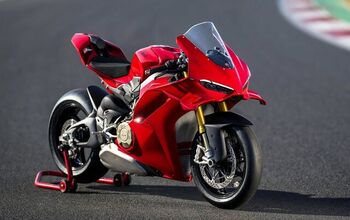

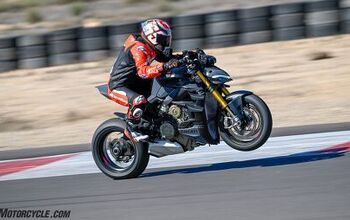
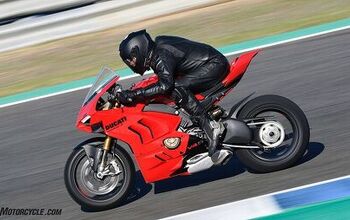
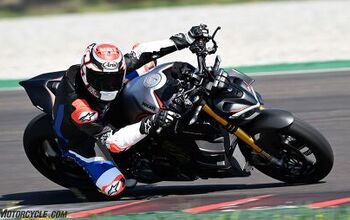




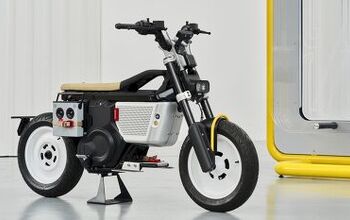



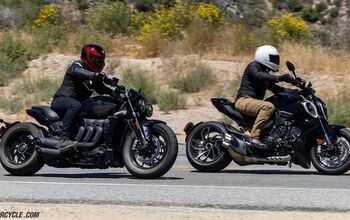


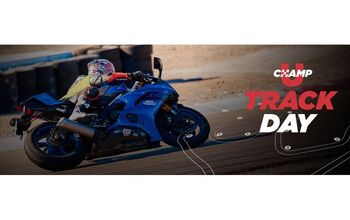

Comments
Join the conversation
All they need to do is remove the wings and this is still a super sexy motorcycle. I wish they'd release a non-winged street version. This bike is things boyhood dreams are made of!
Riding this on the street only and not seeing track duty is like using a semi to tow a tent trailer. Gorgeous bike, but it would be utterly wasted with me at the controls 😄